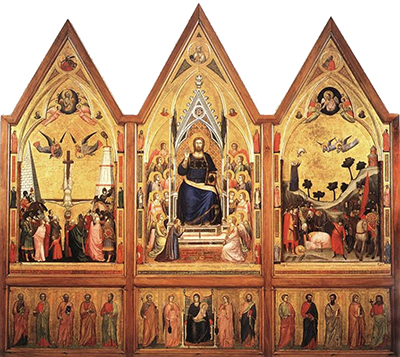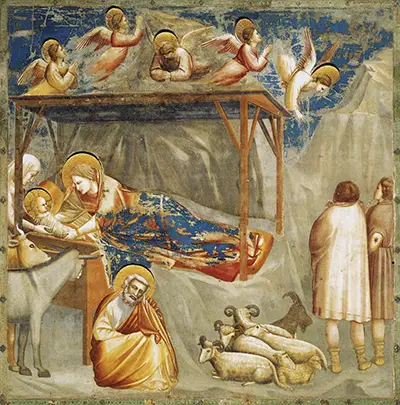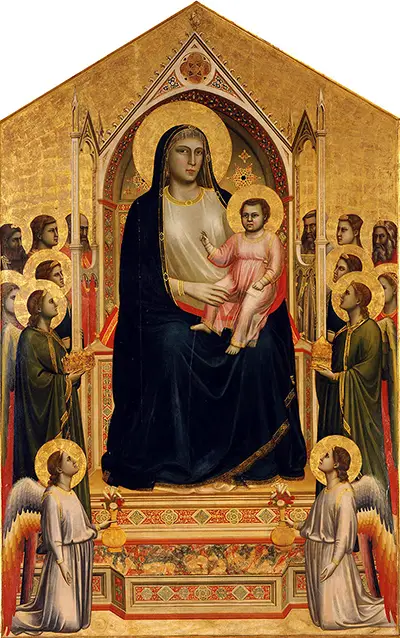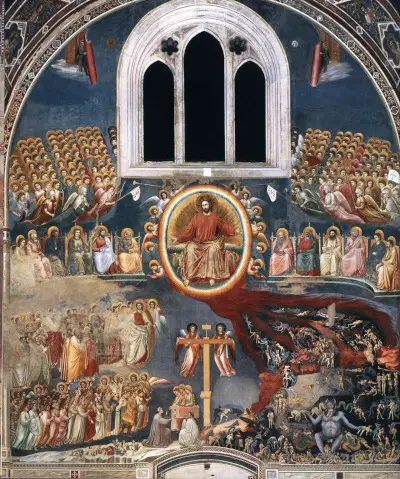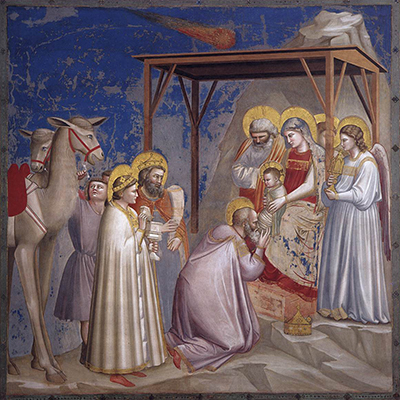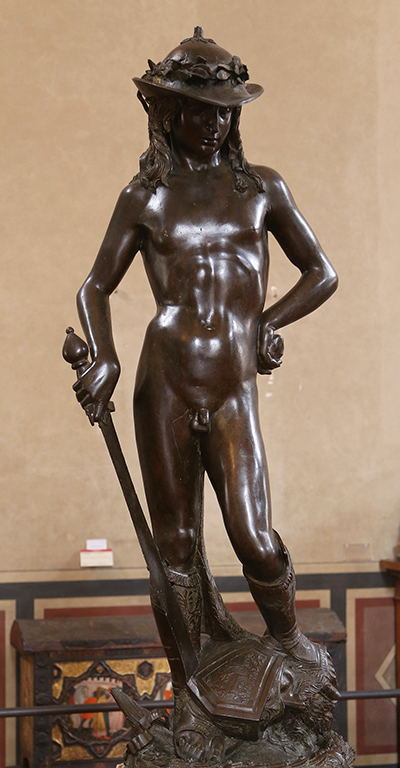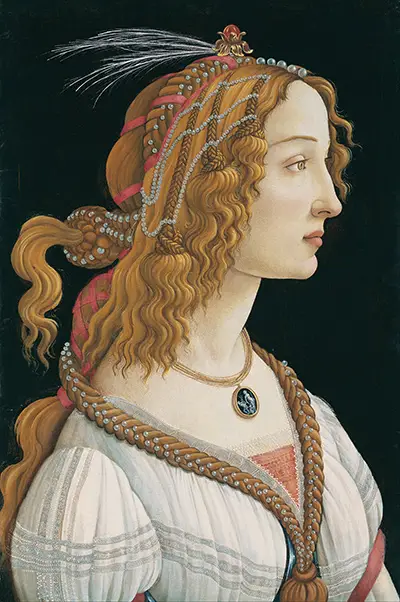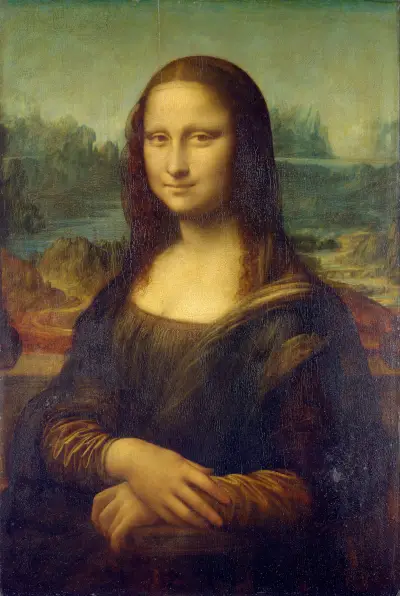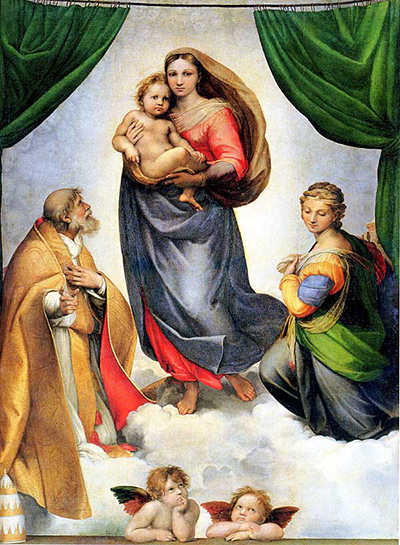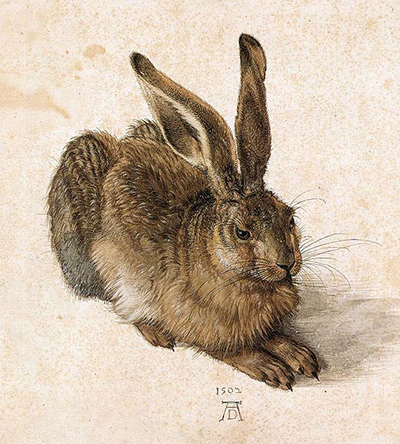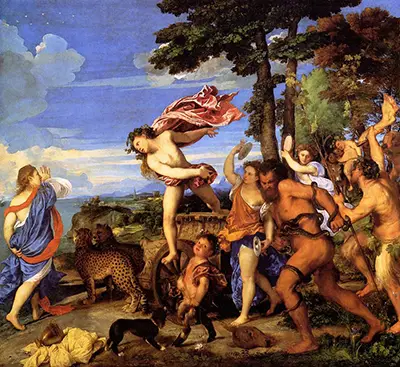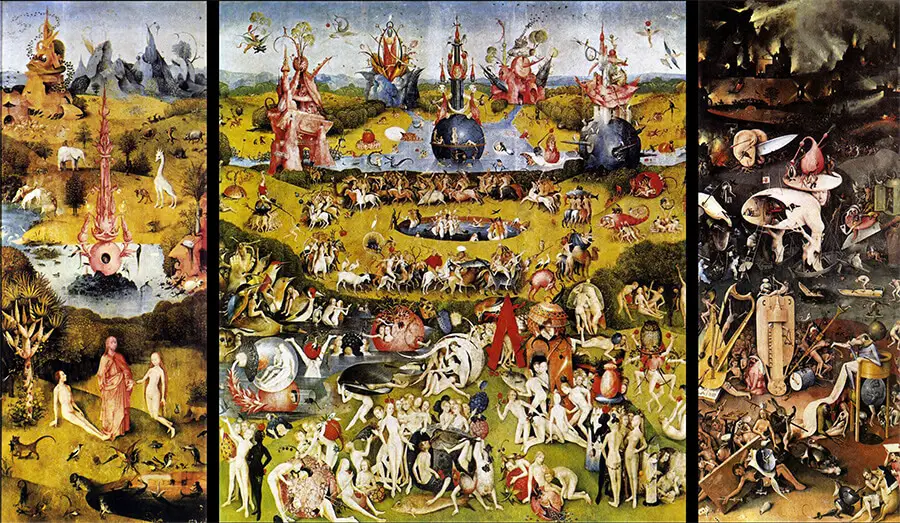The Flight into Egypt is almost as famous a tale as the Nativity itself: the baby Jesus has been born and Herod, knowing that his downfall is in the world, orders the death of every first-born male child in the country.
Introduction
Italian artist Giotto would choose this theme for a famous series of frescoes that were to appear within the Scrovegni Chapel in Padua. The Flight into Egypt would become one of the most memorable artworks to be included here, and he added over fifty artworks in total. This particular theme comes from the Life of Christ, and he would carefully select twenty four different Bible stories to summarise the key events in his life. He would do the same for Mary as well, and then add some additional artworks that completed the interior of the chapel. Interestingly, the artist would then later return to some of these themes for other projects, finding new ways to cover the same content. His work within the chapel is now considered his finest achievement, though historians rarely address the individual artworks, choosing instead to discuss the fresco series as a whole. The chapel was initially intended to be a place of worship for the patron's family and so Enrico Scrovegni would take a particular interest in the delivery of this project. He financed a number of assistants to help out alongside master Giotto, which enabled all of the work to be completed within two years.
The original passage comes from Gospel of Matthew (Matthew 2:13–23) and over time an additional sub-theme has emerged known as the Rest on the Flight to Egypt, which has also appeared within art since around the 14th century. A common format has been developed over the years, a compositional style that allows viewer to identify the content immediately and Giotto's contributions helped to shape this. Whilst the Italian Renaissance would shape European art for centuries to come, it must be remembered that Giotto appeared right at the start, allowing his work to make the biggest impact of all. Many other masters would study his creations and take some of his ideas into their own work, ensuring his techniques and innovations could spread far and wide. There was also an important visual impact to be made with a congregation, allowing biblical words to take on a visual meaning, connecting one closer to their own faith and strengthening the impact of the Church. This was particularly the case at times when many could not read or write themselves.
Giotto's artistic style was dynamic and contemporary for his time, bringing a natural look to many of his figurative work. Perspectives would start to become more realistic, in a move away from the flattened look within the medieval era. His use of colour was also uplifting, with the Scrovegni series memorable for its use of blue throughout, along with other tones for clothing which would only start to fade several centuries later. He carefully crafted the attire of his subjects and also included accurate details with rocky landscapes and architecture suitable for the content. Although he would re-work some of his ideas later in his career in other projects, many of the choices that he made within this series of frescoes would continue across later pieces, with the artist producing a second version of The Flight into Egypt several years later at the Basilica of Saint Francis of Assisi. The fame of this cycle would also lead to other patrons requesting their own versions of similar topics, with Christian themes dominating Italian art throughout the entire Renaissance.
Table of Contents
- Description
- The Story of The Flight into Egypt
- Where can the Story be Found?
- What is the Meaning of this Story?
- How do People Celebrate The Flight into Egypt?
- How many versions of The Flight into Egypt did Giotto Make?
- Where is the Painting found Today?
- Which Paintings accompany this piece within Scrovegni Chapel?
- Which other Artists have covered this theme?
- Large Image of The Flight into Egypt
Description
An angel warns Mary and Joseph to flee with the infant Messiah, and they leave in haste, successfully evading the blood-thirsty king's attentions. Before the Renaissance, art was regarded with a somewhat jaundiced eye by the authorities – who were largely indistinguishable from the Church – as being frivolous, unnecessary and scandalous. Most art, as a result, tended to be based around Biblical stories and characters, and it was only during the 1500s that artists began to dare to insert real characters – people they knew – as these biblical characters, and even to portray normal people going about their daily lives. We take it for granted these days, but Giotto would have been shocked at the idea of creating art for anything except to illustrate Biblical sagas such as this one – even though a contemporary asserted that he 'drew figures and their postures according to their nature', perhaps the earliest signs of the rebellion in art that the Renaissance was shortly to unleash.
Giotto's style is unique: fine, delicate fabrics fall in sculptured folds around bodies that are visibly solid and muscular, he had a brilliant eye for perspective that is seen best in his images of architecture: straight lines receding to the infinity point with such accuracy that it imparts an almost three dimensional effect onto the image. This can be seen in his depiction of the rough wild mountains that form the backdrop against the small family's flight. Mary is seated – as so often – upon a donkey, holding her infant child. Her gaze is raised skywards, where the angel is pointing the way they should go, urgency in his indicating hand and the intensity of his gaze. Joseph leads the donkey, seeming uncertain of his actions, but, presumably trusting that the heavenly messenger will see them right.
Oddly, Joseph's feet seem to be on the wrong legs, perhaps symbolising this uncertainty. A small group watches the family leave, and it is testament to Giotto's skill that it is clear that they are interested in the group's departure and yet unsure if everything is as it should be. The sky is a bright, deep blue and the ground appears to be almost chalk-white. This gives the whole image a cheerful and airy effect that is enhanced by the flattering drapes of fabric, picked out in a range of colours that give provide a cheerful, almost cartoonish aura to the work. The work was completed between 1304 and 1306, going up in a newly built chapel in Padua. The chapel, Scovegni Chapel, is still standing and is packed with frescoes, many by Giotto. Because of this, the chapel now forms part of the immense complex of the Museo Civico of Padua.
The Story of The Flight into Egypt
Joseph is informed by an angel of the need to swiftly flee Egypt. He immediately does so, taking Mary and the young Jesus with him. The dream, in which he receives this message, explains that King Herod will otherwise likely murder the child and so they must move fast. Artists have taken this story into their work, normally picturing the various figures from the Bible who make this journey within their composition. They would add elements of scenery and then style the piece according to the artistic methods used at the time. Examples of the story in the visual arts dates back way beyond the time of Giotto, but few of those would have survived to the present day. Perhaps in order to provide a fresh look, some artists have recently focused on them resting during this journey, underlining the tiring, weary nature of the travellers.
Where can the Story be Found?
The story of The Flight into Egypt comes directly from the Gospel of Matthew (Matthew 2:13–23), with the King James version listed below.
"...And when they were departed, behold,
the angel of the Lord appeareth to
Joseph in a dream, saying, Arise, and
take the young child and his mother,
and flee into Egypt, and be thou there
until I bring thee word: for Herod will
seek the young child to destroy him..."
What is the Meaning of this Story?
The Bible does not explain much about the journey itself, which has allowed, perhaps even forced, artists to fill in the blanks themselves. This is how the Rest of the Flight into Egypt came about in the around the 14th century, as artists sought new twists to this popular story. The overall message is perhaps re-inforcing the message around the high level of care that was given to the young Christ in order to protect him. He had a greater purpose, which was understood by those around him, and so he must be kept out of harm's way by any means possible. It also shows how even seemingly ordinary people can escape the clutches of a ruling monarch if they have help from a divine source, which in this case was the angel's message within Joseph's dream. Christ's struggles continue throughout the tales of his life, though with moments of influence too which can inspire followers as well as reminding us of the struggles that we all experience within our own lives.
How do People Celebrate The Flight into Egypt?
The second-largest Christian Church, the Eastern Orthodox Church, celebrate the flight into Egypt on December 26. It is often known as The Feast of the Holy Family of Jesus Mary and Joseph. In recent years, of course, this same day has become known by many as Boxing Day, in which boxed gifts would be given to the poor. The commercialisation of many societies today has led to this meaning being replaced by a focus on shopping sales, where individuals take a more selfish approach to the day. It is still common within more religious communities, however, to stick to the original meanings of the day and regular celebrations continue to be organised every year within those groups. As a further note, French people in the middle ages often celebrated this event during Feast of the Ass, which refers to the animal on which Mary and Jesus would travel.
How many versions of The Flight into Egypt did Giotto Make?
Giotto also produced a large amount of work for the Basilica of Saint Francis of Assisi and as part of that commission he would create an alternative version of The Flight of Egypt. That piece is dated to around the 1310s and is in a better condition today than the chapel version, allowing us to appreciate more of the original detail that he added. The background is more carefully crafted, with elements of architecture added to both sides. We can see a clear development in his style when comparing the two different versions, though the composition, as well as the figures in both, remain fairly similar. It may have been that his experience within the initial design brought about some new ideas which could then be worked on when this next opportunity arose. There has been some incorrect attributions to the paintings within the Basilica of Saint Francis of Assisi over the years, because of how many different artists worked there at different points, but one can immediately see the style of Giotto within this particular addition and so there are no questionmarks about that piece.
Where is the Painting found Today?
The Flight into Egypt by Giotto was painted between the years of 1303 and 1305. It was produced as part of his cycle of frescoes for the Scrovegni Chapel in Padua, Italy and it remains there today. There were several artworks focused on themes from the Life of Christ and the Life of Mary and these would be placed in rows across the north and south walls. Giotto himself designed all of the artworks, but allowed his assistants to complete parts of the painting process, as otherwise it would have taken him years to finish off this ambitious project. The Flight into Egypt can be found on the middle tier of the south wall and this row also includes The Nativity of Jesus, The Adoration of the Magi, The Presentation of Jesus at the Temple and The Massacre of the Innocents. All of the items within this series were of the same size in order to keep a consistent layout across both walls, with the frescoes each sized at 200cm by 185cm, making them almost square in dimension. You will also notice a conssitent look throughout the series, suggesting a strong hand from Giotto in supervising the work of his assistants, to avoid individual artworks drifting off from the overall look.
Which Paintings accompany this piece within Scrovegni Chapel?
As mentioned, the painting sits alongside Presentation of Jesus at the Temple, Nativity of Jesus, Adoration of the Magi and Massacre of the Innocents on the middle tier of the south wall within the chapel. Giotto added twenty four artworks in total on Episodes from the Life of Christ along with two corettos. Perhaps the most famous of them all would be Lamentation, but generally speaking historians have mentioned this series as a whole, rather than focusing on individual elements of it. The chapel interior also includes the same number of frescoes for themes from the Life of Mary, and then there are some additional works to fill the other sections of the room, where items had to be custom made to fit. The Last Judgement fills an entire wall, for example, around the entrance to the chapel. There was also the lesser known series of the Vices and Virtues which featured narrower, simpler portraits that completed the overall commission which was delivered in around two years. The overall body of work continues to be regarded as the finest achievement made by Giotto across his entire career.
Which other Artists have covered this theme?
All of the themes found within Giotto's cycle of frescoes for the Scrovegni Chapel would appear in the careers of other artists, both before and after his own contributions. Giotto himself would influence many Italian artists in their own interpretations, with some notable names having visited the chapel themselves in search of inspiration. The early periods of the Italian Renaissance would also impact artists across the rest of Europe too. In terms of the Flight into Egypt itself, as well as other stories from the Bible which relate to this passage, some notable artistic contributions have been made by the likes of Peter Paul Rubens, Fra Bartolomeo, Philipp Otto Runge, Joachim Patinir and also Gentile da Fabriano. Rubens' version remains the most famous of all, followed by Giotto's Scrovegni Chapel version, but this may be more due to the fame of the artist himself, rather than the composition itself being particularly impressive. Giotto's own work is also well known because of the public's knowledge of his wider cycle series for the chapel. Other great names to have focused on this topic include Titian, Albrecht Dürer and Nicolas Poussin.
Large Image of The Flight into Egypt
In order to appreciate the detail added by Giotto and his assistants, we have included a larger image of the painting below. Although the chapel itself is accessible, it is not easy to acquire high resolution photographs of the frescoes, because of the way in which they are positioned around the chapel. Most are in rows well above head height and the whole area is understandably protected against too much interference from visitors. You will therefore find that better images can be found of his paintings produced elsewhere, particularly when on panel rather than installed in specific locations. The location in and around the Chapel has been recognised as a place of great cultural significance which also adds further importance to the site itself, with preservation work regularly carried out on the chapel itself as well as Giotto's frescoes which remain inside. Generally speaking, most historians discuss his Scrovegni Chapel paintings in their entirety, as a cycle, rather than really analysing each item individually.
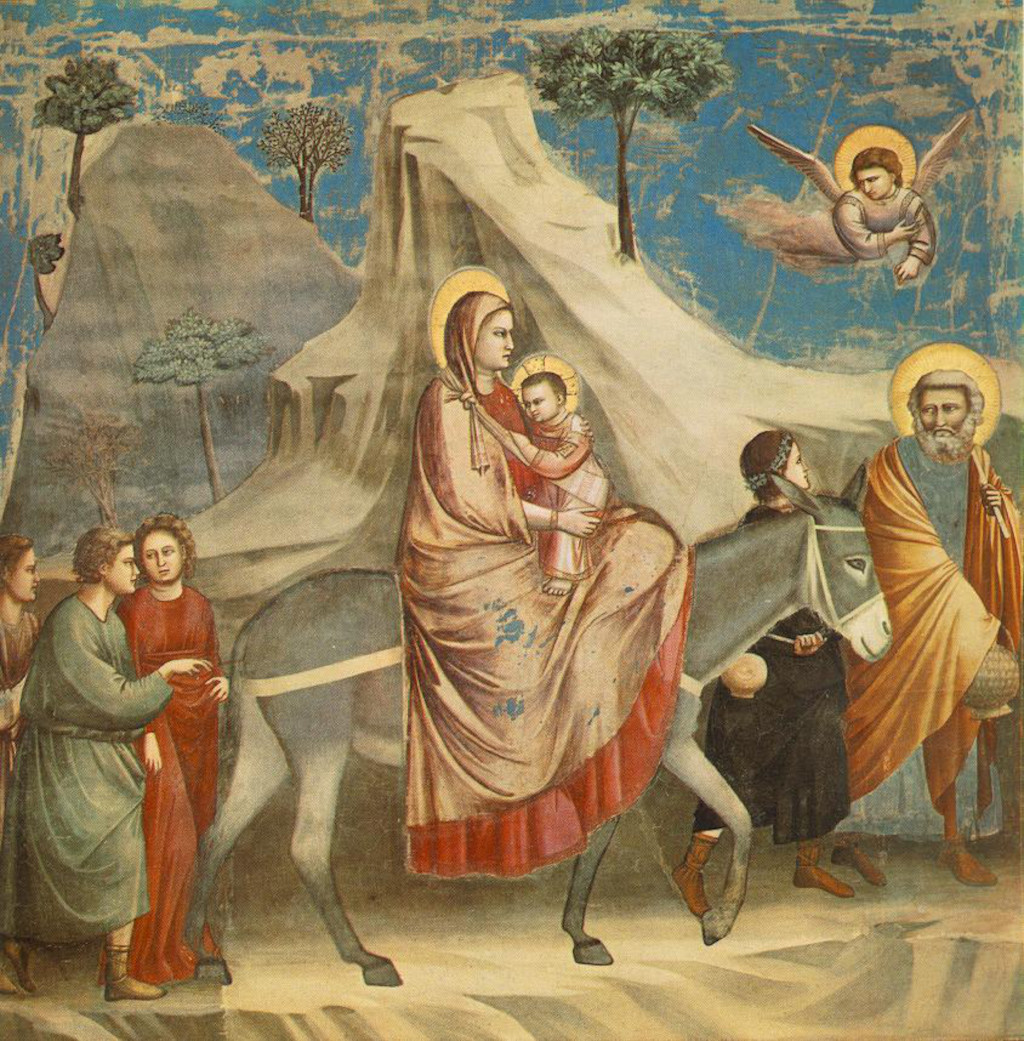
More Renaissance Artists



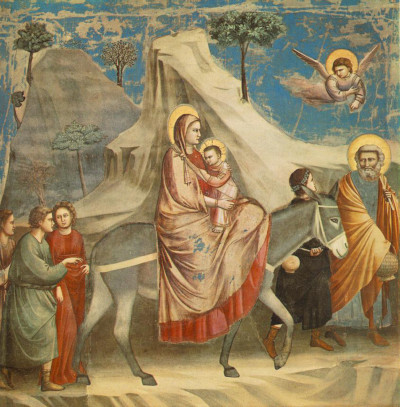
 Giotto.jpg)
 Giotto.jpg)
